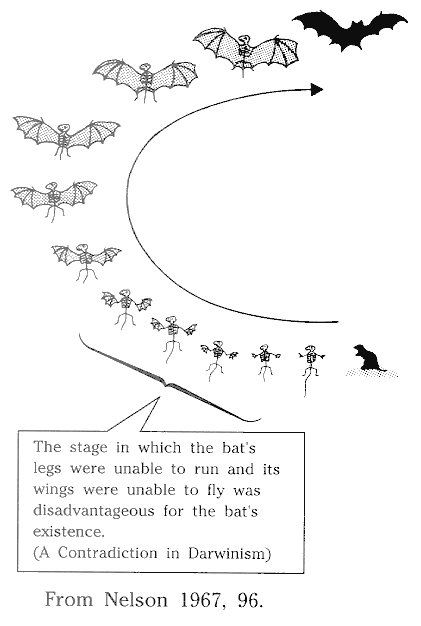Did the front legs of a mouse evolve into the wings of a bat?
The theory of natural selection explains that, out of a wide range of variations of living beings, the advantageous ones, that is, those better adapted to exist, will be selected, and the less advantageous ones will perish. It has now been made clear that the variation with which evolution is connected must be "mutation." Yet, as has been seen, mutation is random, directionless, and mostly harmful and destructive. How can a complex and high-level new species be formed through natural selection based on mutation, which has the features described above?
Concerning the character of natural selection, Darwin said the following: "Natural selection can act only by the preservation and accumulation of infinitesimally small inherited modifications, each profitable to the preserved beings" (Darwin 1968, 142). A big change occurs through this accumulation of very small changes, he asserts. And he stated, "If it could be demonstrated that any complex organ existed, which could not possibly have been formed by numerous, successive, slight modifications, my theory would absolutely break down" (Darwin 1968, 219).
Yet, when we consider that living beings evolved by gradual stages, there are too many leaps that cannot be explained by natural selection. For example, the leap from the asexually reproductive living beings to the sexually reproductive living beings ; the leap through which the eye and the ear came to be formed ; and the leap through which the nest-making instinct emerged in bees and spiders.
Darwin was acutely aware of the difficulty derived from such problems: "To suppose that the eye, with all its inimitable contrivances for adjusting the focus to different distances, for admitting different amounts of light, and for the correction of spherical and chromatic aberration, could have been formed by natural selection, seems, I freely confess, absurd in the highest possible degree" (Darwin 1968, 21'x. Nevertheless, holding fast to the theory of natural selection, he said that, if the stages up to the perfect eye existed-each of the stages being profitable to the living being-then a perfect and complex eye could be formed by natural selection.
This question remained, however, unresolved even after Darwin. Dobzhansky admits this point as well.
Perhaps the most troublesome problem in the theory of evolution today is how the haphazard process of chance mutations and natural selection could have produced some of the wonderfully complicated adaptations in nature. Consider for instance, the structure of the human eye-a most intricate system composed of a great number of exquisitely adjusted and coordinated parts. Could such a system have arisen merely by the gradual accumulation of hundreds or thousands of lucky, independent mutations ? (Dobzhansky 1963, 40)
Darwin claimed that the theory of natural selection should be regarded as valid provided the intermediate stages proceeding toward a new complex organ were useful for the living being itself. However, as widely pointed out, the processes through which a new organ was to be formed, namely, the incomplete stage in which the new organ is partly formed, is no more than a disadvantageous stage for that living being's life. For example, a bat is considered to have evolved from a mouse-like animal. But when the front legs of the mouse-like animal were changing into wings, that animal was in an intermediate state in which legs could not be distinguished from wings-and in that state that animal must have been unable either to fly or to run. Therefore, such a state would have been unfit for the animal's existence (see Fig. 11). In that intermediate stage, the animal would not have been selected by nature to survive but would simply have been weeded out. This is a fundamental difficulty in the theory of natural selection.

Fig. 11: The Imagined Evolutionary Path of the Bat
To deal with this problem, Stephen J. Gould, a representative American evolutionist, suggested the concept of "preadaptation." He said that, in the stage where a structure of a living being, useful for its existence, was still imperfect, that structure performed a different function. For example, fishes did not have jaws in the beginning; but the bones that had another purposethe bones that supported a gill arch located just behind the mouth-happened to be fit to become jaws. Therefore, those bones became jaws. Gould explains it: "The bones were admirably preadapted to become jaws" (Gould 1977, 108). Therefore, even in the stage where jaws were being formed, fishes did not have any trouble in their use, he says. We cannot but question the validity of such a view. As could himself admits, his concept of preadaptation cannot explain the formation of all the different complex organs.
I do not doubt that preadaptation can save gradualism in some cases, but does it permit us to invent a tale of continuity in most or all cases? I submit, although it may only reflect my lack of imagination, that the answer is no. (Gould 1980, 189)
Nobody has succeeded in reasonably explaining, by the theory of natural selection, the gradual stages up to the formation of exquisitely perfected and sophisticated organs.
Now, let us touch on the "theory of neutral mutation," advocated in 1968 by Sukeo Kimura, a Japanese geneticist. According to this theory, when the variations of a living being are seen on a molecular level, the majority of mutations are neither profitable nor unprofitable but neutral to living beings. In other words, mutations can be neither selected nor rejected by natural section-but are accumulated accidentally in the species through "random genetic drift." Such a neutral mutation becomes activated at some time to appear suddenly as a useful character.
The theory of neutral mutation is attracting world attention today, obtaining world acceptance, and has come to threaten the authority of Neo-Darwinism, which regards natural selection as almighty.





